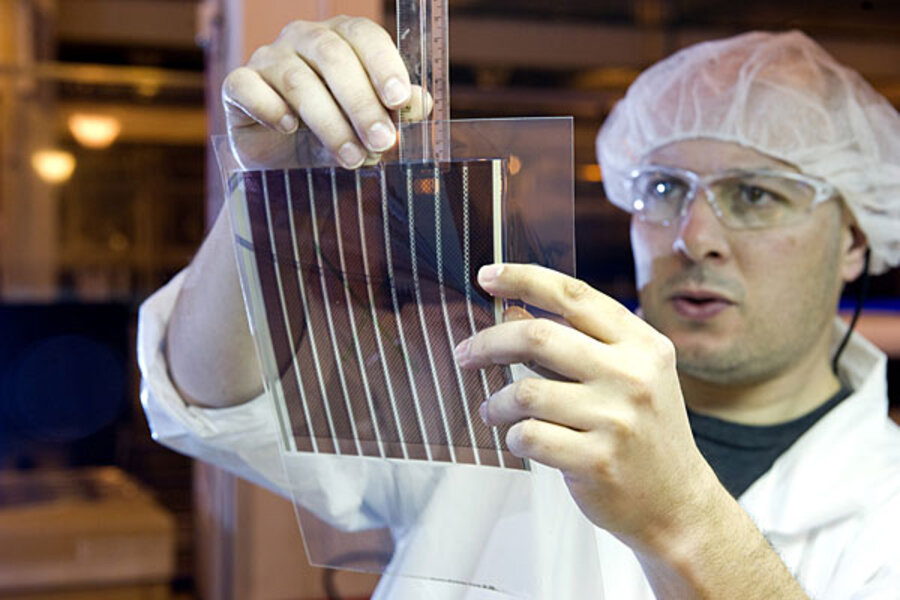Earth Day technology: the spray-on solar panel?
Loading...
| New York
The solar energy industry is thinking beyond the roof. Instead of those large flat rooftop solar arrays, some companies are trying to convince architects and builders to use windows to generate electricity using nearly transparent plastic film that can be sprayed on or rolled on with an adhesive.
How about inside the building? The same technology can be used to collect juice from ceiling. As the world celebrates Earth Day, the solar industry is trying to capture energy in places never considered before.
“It puts energy harvesting everywhere,” says Ken McCauley, a senior vice president at Konarka, a Lowell, Mass., company that is producing electricity from solar cells printed onto thin plastic film.
There could be widespread implications if this young arm of the solar industry takes off. The technology is under consideration for everything from cellphones to the sunroofs of luxury cars, but any big gains would come if thin-film solar takes off in buildings, which currently consume 40 percent of the nation’s power. That would reduce America’s carbon footprint. If it can bring down costs, America’s solar industry could also get a leg up on Chinese competitors, who currently command nearly half the world’s solar market but apparently have not yet mastered the new technologies.
“There is room for enormous innovation,” says Christiana Honsberg, director of the Arizona State University Solar Power Lab. “We are only limited by the imagination.”
Unlike most conventional solar cells based on silicon – which is very energy intensive to produce – some of the new solar cells are quite different. For example, New Energy Technologies, based in Columbia, Md., has developed plastic polymers that can be sprayed on windows to create a film to produce electricity. Called SolarWindow, the process generates electricity using natural or artificial light, such as fluorescent lighting.
“It will generate electricity even in low light conditions, so you can coat windows that are facing east or west,” says , says John Conklin, chief executive officer of New Energy Technologies. The technology can also generate some electricity from windows on the north side of a building, which usually only gets reflected light. In addition, he says, the company is looking at offsetting a building’s energy use by utilizing the inside of the window, as well. Mr. Conklin, whose firm is developing the technologies with the National Renewable Energy Laboratory and the University of South Florida, is now looking for a partner in the flat glass market.
“The principal characteristic of many of these alternatives to silicon is that they have lower efficiency but generally lower costs,” says Sam Shelton, director of research programs at the Georgia Tech’s Strategic Energy Institute in Atlanta. A ballpark estimate of the cost of using electricity from conventional solar power – at the generator site and without government subsidies – would be 15 to 20 cents per kilowatt hour (kWh) compared with 10 to 15 cents for wind power, 12 to 16 cents for nuclear, and 5 to 7 cents for coal.
The challenge for these young companies is to reduce costs enough to convince architects and builders that their lower-efficiency solutions make sense. Neither New Technologies or Konarka has released information on their costs per kWh. New Technologies says it’s a developmental company still working on its product. Konarka says the cost per kWh depends on the specific application of its product and where it’s mounted.
Even more challenging for them is that these cost targets keep dropping because Chinese competition is driving down the price of conventional silicon solar panels. The price drop, combined with a reduction in German government subsidies, is one factor behind the bankruptcies of several major German solar cell companies this month. The US subsidiary of one of the German companies, Solar Trust of America, also filed for bankruptcy. It holds the developmental rights to a huge solar project in California.
US manufacturers have charged that Chinese companies, who now have 48 percent of the world market, are selling solar cells below cost. President Obama has already tacked on some tariffs and more may be coming. In May some of the Chinese manufacturers may face anti-dumping penalties.
Many of the new US companies are trying to protect themselves from the Chinese by registering their processes with the US Patent Office. For example, New Energy Technologies has filed 10 patents on its spraying process.
However, there are plenty of skeptics about the new technologies.
“What matters is the area on the roof,” says Mike Knotek, director of the Renewable and Sustainable Energy Institute at the University of Colorado, Boulder. ““If you don’t have direct sunlight, you have a problem.” To him, window technologies getting only light for part of the day are at a tremendous disadvantage.
But Mr. McCauley argues that the new technology has some advantages over those big silicon cells. For example, to make a traditional silicon unit requires a lot of energy to heat the raw material up to 1,400 degrees. “It takes two years to get the energy back that went into it,” he says.
And costs are not the only factor. “Look at the LEED standard,” he says, referring to the Leadership in Energy and Environmental Design criteria for “green” buildings. “It’s not all about energy costs but also sustainability and green materials and local sourcing. On top of that, these different organizations and building owners want to reduce energy consumption and for every reduction, the value of the building goes up.”





